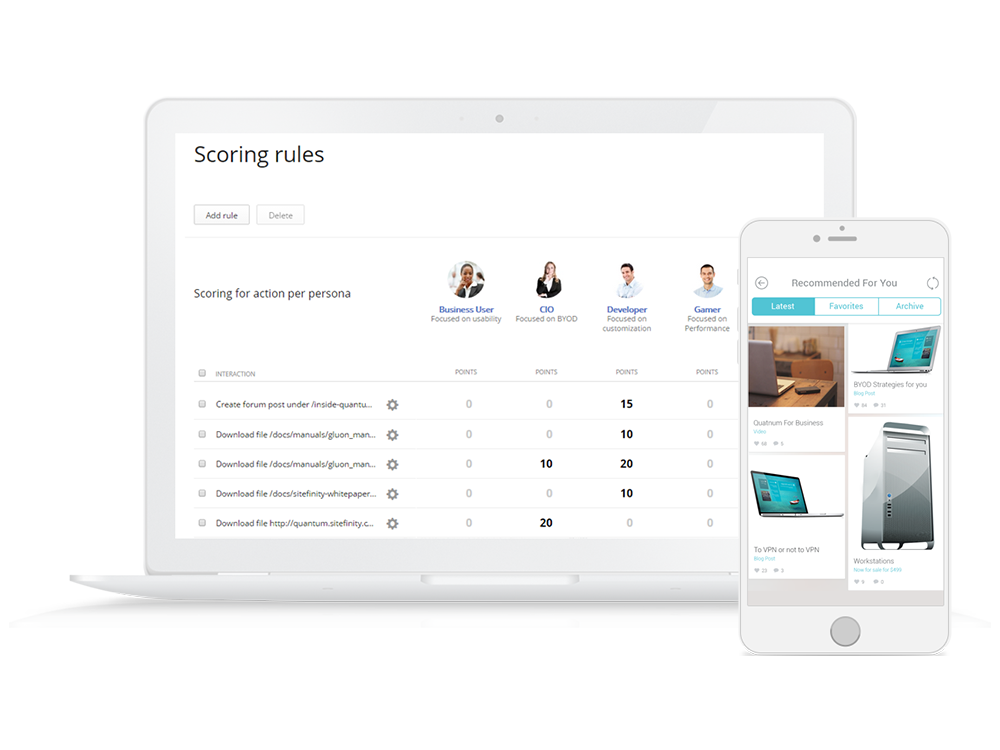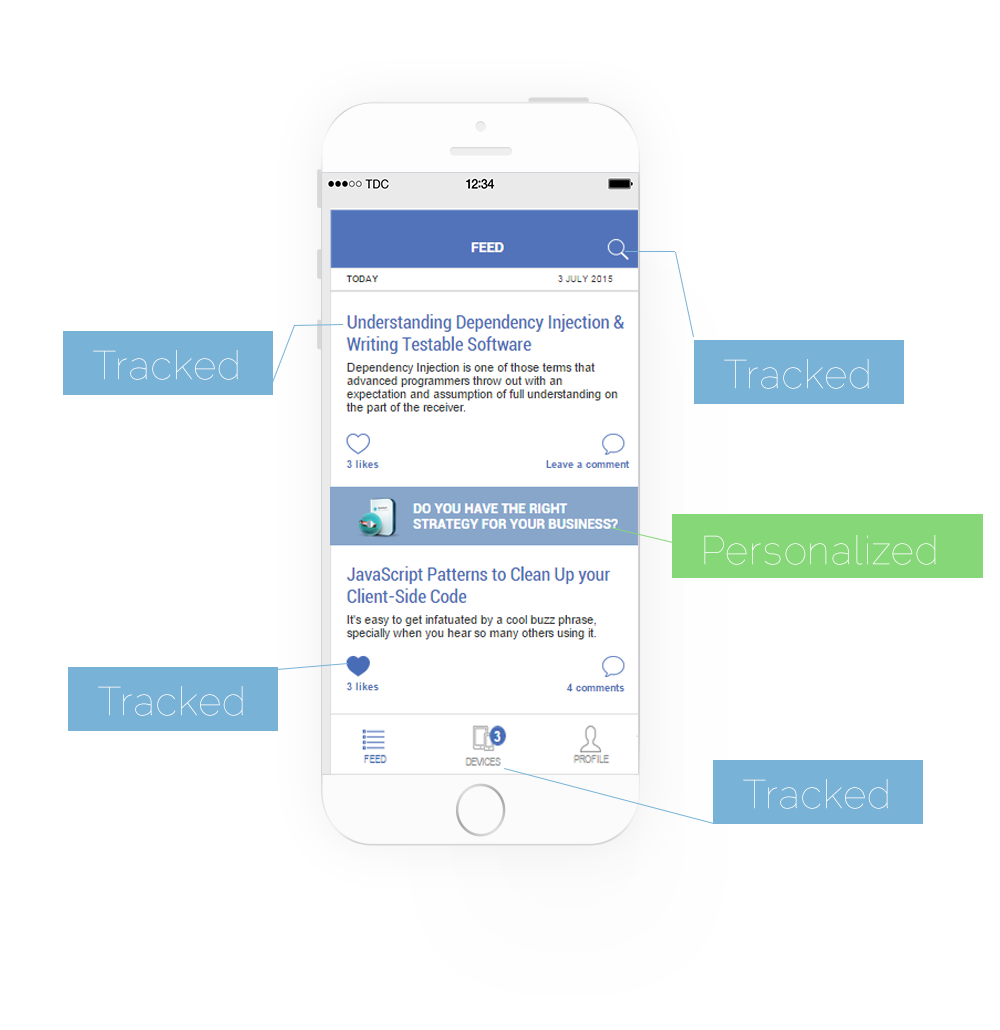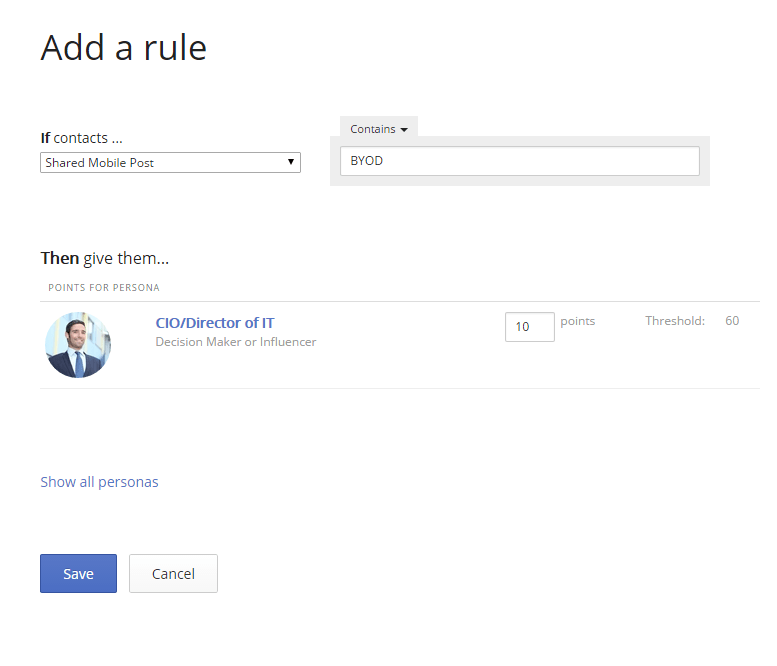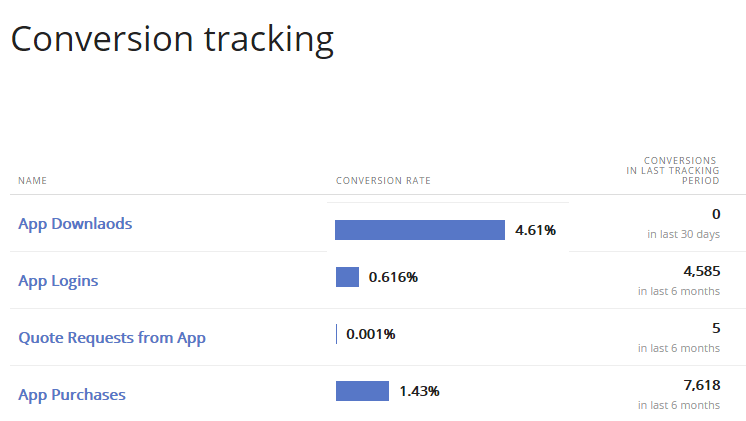Insights and Personalization for Mobile Apps with Progress Sitefinity 8.1

Among some of the very exciting announcements for Sitefinity 8.1 is one new capability that marks a very important step in bridging web, mobile, personalization and analytics. The new Mobile SDKs bring personalization and customer journey optimization directly to the world of mobile apps and this could open some very exciting opportunities for you. In this blog post we will discuss some of the business benefits, use cases and specifics of this new capability.
What’s the idea behind the Mobile SDKs?
There are two very crucial guidelines for businesses today and on a first glance they seem a little bit contradictory.
- You must ensure a consistent message across channels.
- You must personalize the message to each visitor’s context on every channel.
Hold on. How can a message be personalized and yet be consistent? In earlier days when there was one message and one channel - the web - this was easy. One message = consistent message, no problem.
But what happens if you want to personalize? Well, a lot of you solved this problem with easy to manage frameworks such as personas. Personas help with consistency, because they put order in the complex universe of thousands and probably hundreds of thousands of unique potential buyers. With Personas you just put them into buckets, use various interactions to profile who falls within each bucket and build separate messaging and content for each persona. This way you can strategically use solutions such as Telerik Sitefinity to target visitors with persona-specific messages. Each visitor sees the right message for their context and they don’t need to know that alternative versions of that message exist.
But what happens if you add another channel such as a mobile app? Sure, your mobile app can completely disregard your personalization efforts and your persona profiling could completely disregard mobile app behavior, but this way you compromise both message consistency and relevancy. But what if you could utilize the same personalization engine between your apps, your websites and any other applications?
Here is where integrated mobile personalization and analytics come into play. The worlds of mobile and online are quickly converging and businesses are heavily investing in new digital offerings, especially in mobile. As a part of that trend we started seeing two critical growth drivers:
- Businesses want to know how behavior in different applications, including mobile applications, is connected to behavior on the website and how the combination of both impacts buying decisions. Let's say I invest in a mobile app and 20% of my visitors download the mobile app, but only 1% of them actually log in. Then let's say that out of those who actually log in 40% make a mobile purchase, then sure, I have accomplished great mobile success, but it becomes even more obvious that I need to improve that 1% conversion rate. If I can figure out why they don’t log in and fix the problem, I could make a very sizable impact on mobile revenue and revenue in general. But I may not even motor the conversion to login or know that this gap actually exists, let alone know how to fix it.
This of course is an example, but customer journey mysteries like this one exist for every business. Every marketing team has a set of turnkey conversion rates that they wish they could double, triple or quadruple and Sitefinity Insight provides a set of comprehensive tools to help you accomplish that. - Businesses want to leverage cross-channel insight and impact outcomes.
If I learn that someone behaves like a CIO based on the information that they browse on the website, I want to be able to use this information on the web and within mobile apps. This not only lets me promote more relevant products and content and improve my conversion rates, but it also gives my CIO visitor a more compelling first experience with the mobile app, as they will be seeing a relevant message even upon the first visit. Being relevant from the get-go is a sure way to increase adoption of any digital service I offer – be it an app or anything else – as you have a limited time window to catch your visitor’s attention to begin with.
How do the Mobile SDKs work for Personalization and Insights
The Telerik Sitefinity 8.1 Mobile SDKs provide JavaScript based tracking and personalization codes and can work with any hybrid mobile application such as the ones built with Telerik AppBuilder and the ones generated by Sitefinity Mobile App Builder. Developers can easily plug these tracking codes and track interactions. Developers can also request information from analytics and learn as which persona does a person belong to so that this data can be used for mobile targeting.
Integrating native apps is also possible as the system provides these services as RESTful APIs that can work with any of the native or cross-compiled languages such as NativeScript.
There are two components of the Mobile SDKs: tracking and personalization.
- Tracking:
The idea here is to integrate tracking of mobile app behavior and capture it with the entire customer journey. Interactions within mobile apps can be very valuable indicators of purchase intent, context or interest. If a user searches for something in an app, clicks on a notification or an offer banner or uses a certain feature this could tell us a lot about this user. Even registering or logging into the app can be a conversion goal by itself. For that reason tracking within the mobile SDKs can be instrumented to capture absolutely any interaction – clicks, swipes, taps, zooms, toggles, logins, even exceptions and errors. The type of information tracked can be classified in two ways:
- Behavioral tracking. This is tracking of things that can explain what the user has done. Tracking in Sitefinity resembles natural language and is logged as sentences, so within behavioral tracking the sentences typically have the word “HAS” such as:
- User has purchased laptop
- User has searched for “laptop bag”
- User has logged in.
- User has opened the Profile View
You can log any interaction as a human readable sentence and you get to decide on the verb and the object(The sentence subject is typically the current user, anonymous or not)
- Parameter tracking. This is tracking of who the user is and what information they provided about themselves within forms, user profiles etc. Here you can imagine sentences that have the verb “IS” instead:
- User IS from Mountain View
- User IS a Marketer
- User IS Female
- User IS going to beat user Anton Hristov at table tennis (some very accurate predictive analytics were used for this one)
2. Personalization
The personalization SDK essentially provides a way for you to know:
- Which persona does a current mobile user belong to?
- What is the current user’s lead score?
- Which campaign do they belong to?
Based on this information your developers can change any app behavior - form showing a slightly different message or promotion to changing the entire features and navigation of the app. Both the tracking and personalization scripts can work together at the same time to monitor the experience, personalize it and even monitor interactions with personalized experience to answer questions like “How much more likely is a CIO to become an opportunity if we show a personalized message”.
Use case scenarios
This cross-channel personalization framework is not about what you can track, everything can be tracked and that’s just the beginning. The business value comes from what business units can do on top of this information. Having unified data for web and mobile journeys opens dozens of new opportunities for you and hare some of the core use cases that you can take advantage of right now.
- Behavior tracking can be incorporated in Persona Scoring or Lead Scoring. If someone logs into the app – they get 20 points to being a lead. If someone shares a post about an IT specific topic, they get points for being more like a CIO. These are all rules that marketers can decide on and rules that can change over time through a user-friendly persona-definition interface.
- You can measure how mobile features impact your business goals. Let’s say you’ve invested time in a mobile feature like push notifications. With Touchpoints and Attribution you can measure how much more likely is someone to purchase, request a quote or engage in any other way if they click on a push notification vs the average and how many purchases have you actually gotten from there. This helps you gauge mobile content and mobile features according to their impact on your goals, which is a very strong indicator that can help you justify further investments or fix gaps.
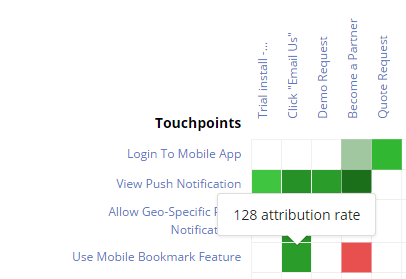
- You can track mobile conversions such as mobile purchases, logins and use of certain features. You can also use the predictive analytics and personalization engines to improve these conversions. In a digital world often adoption is just about an important goal as conversion, especially if you are investing in a new channel such as mobile. With Sitefinity Insight you can easily monitor adoption metrics as a part of your Digital Command Center.
- You can target a message based on the persona – showing a relevant promotion, applying filtering, filtering only the persona-specific push notifications and so on.
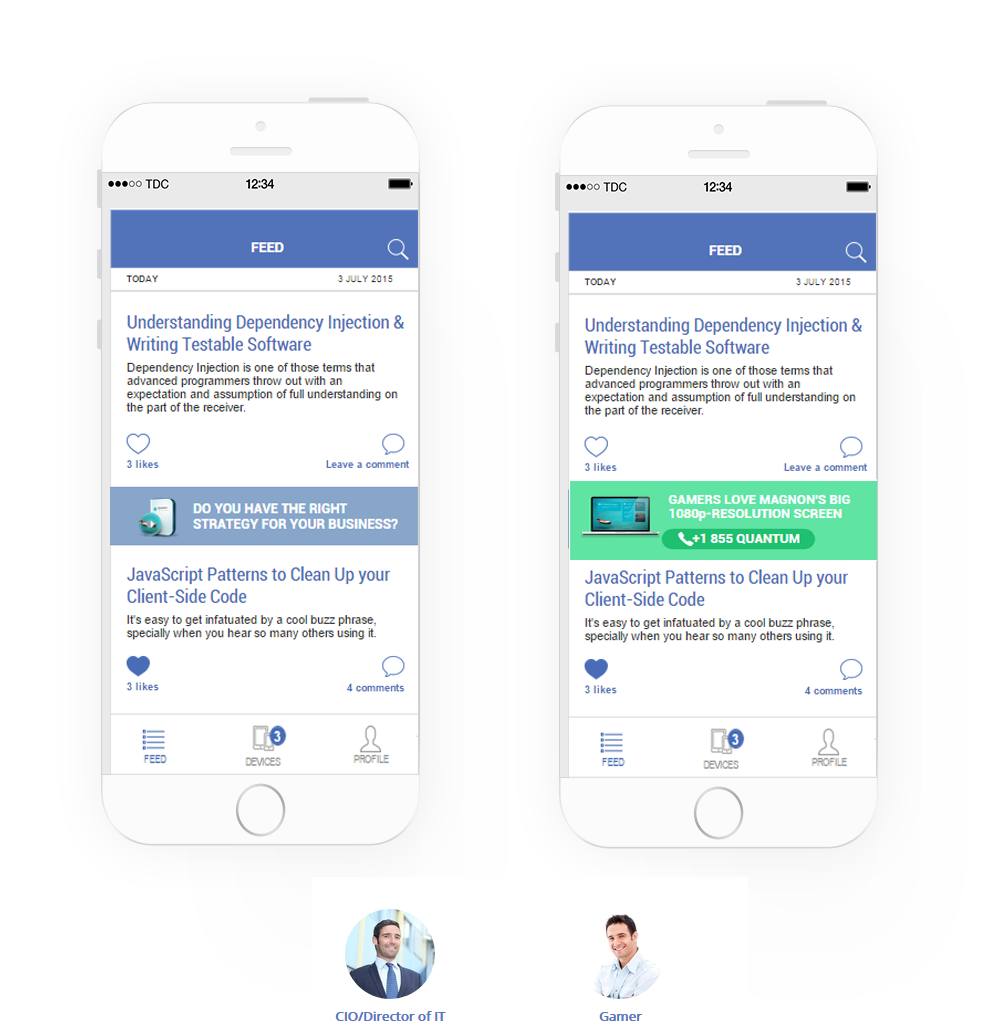
- You can account for a lead score – the likelihood to convert – and start shifting from informational content to targeted offers as that score increases. Scoring is a powerful tactic that can be used not just for purchase intent, but for some other very interesting purposes as well. For example, you can create “Frustration Scoring” that takes into account any errors or exceptions thrown in an application and send over a coupon code and a follow up once the frustration level gets high.
Beyond Mobile
There is more good news to this announcement. The tracking and personalization SDKs work beyond the context of mobile. Because the SDKs are JavaScript based they can work on any custom websites or applications you have. They don’t have to be running Sitefinity or abide by any specific rules.
You can track any interaction in your apps and see which features are being used and why. You can utilize the user's persona and make your application dashboard and features more targeted to their needs. You can also use application behavior for the purpose of persona profiling – if a user clicks on design features, they are likely a designer, if they browse developer features, they are likely a developer.
This way your custom applications can become powerful marketing channels that showcase relevant offers and promotions to your users and at the same time add value based on the specific problem they solve. This is exactly the business model behind digital giants such as Google and Facebook.
The basic principles of contextualization and targeting go far beyond the website and we are excited to continue delivering features that combine these principles to a much broader framework that can achieve true integration between cross-channel data, analytical insight and content targeting.
If you wish to explore contextualization opportunities for your specific web and mobile projects, don’t hesitate to reach out to us.
Happy Sitefinity 8.1 Release and Happy Personalizing!

Svetla Yankova

Latest Stories in Your Inbox
Subscribe to get all the news, info and tutorials you need to build better business apps and sites
